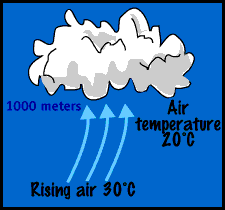
Cloud formation can be classifies into three main categories:
Each type is based on the same general principle. Warm air is less dense and holds more water vapour than colder air. As warm air rises into the upper troposhpere, for whatever reason, its pressure will decrease, the air mass will expand and the temperature of this air parcel will drop. This is all part and parcel of what you will learn as the Gas Laws. As the temperaure decreases the vapour pressure of the water drops and gaseuos water must condense into the liquid form. The microscopic water or cloud droplets condense together and form a cloud.
Here is a simplified diagram of this event

See your text book for the exact differences in each of the cloud formation types. Page 530
This one is for you. So go to your text book page 532 & 533 and visit the two links listed below. This is a learned and remembered type of topic. If you cannot tell clouds apart you simply have not studied enough.
And don't forget fog